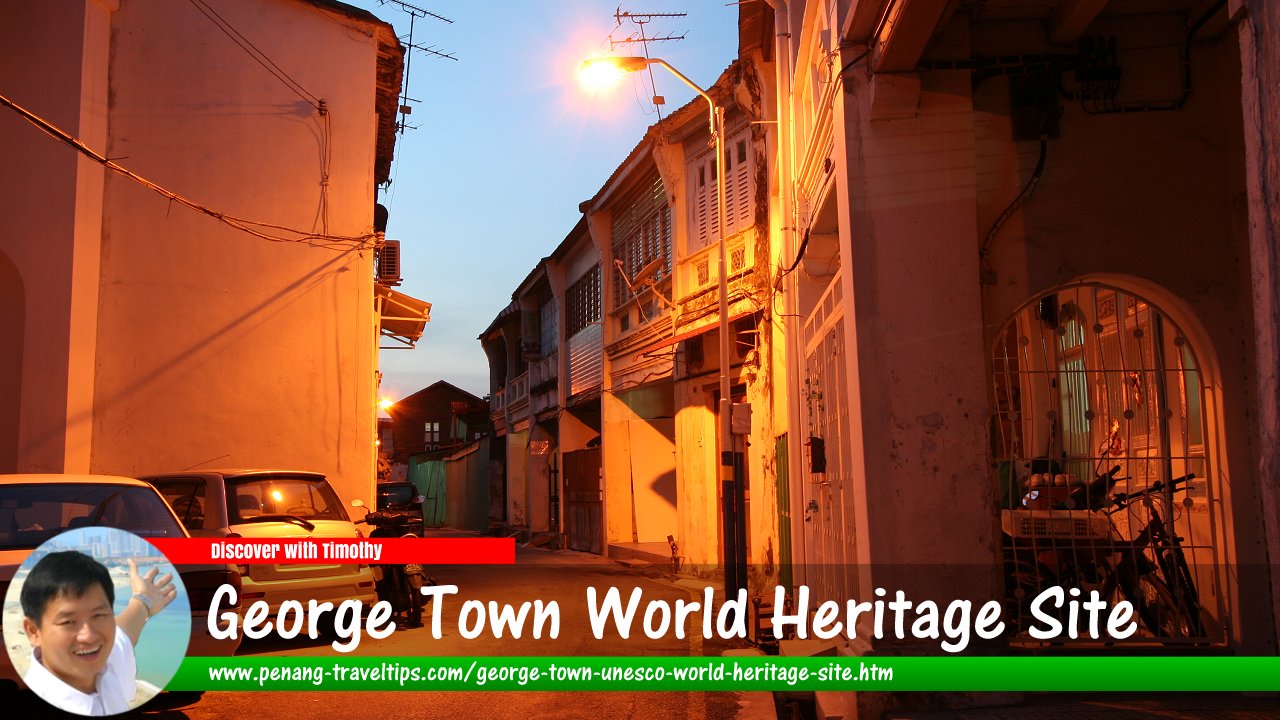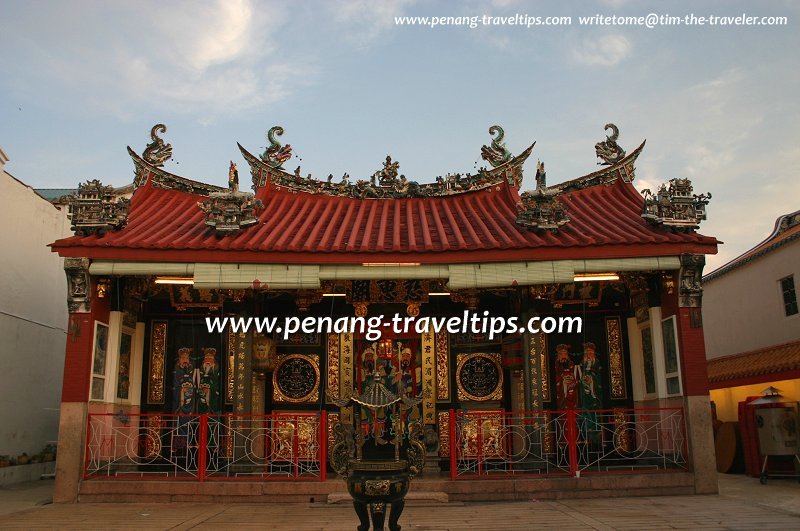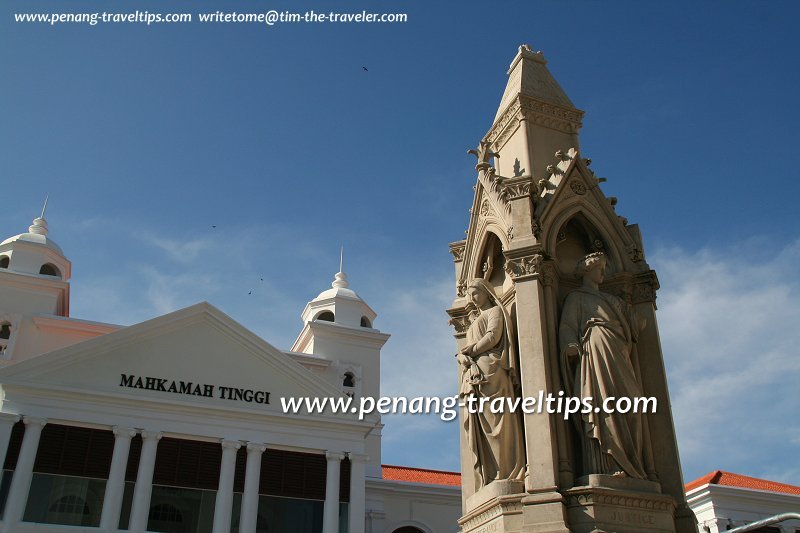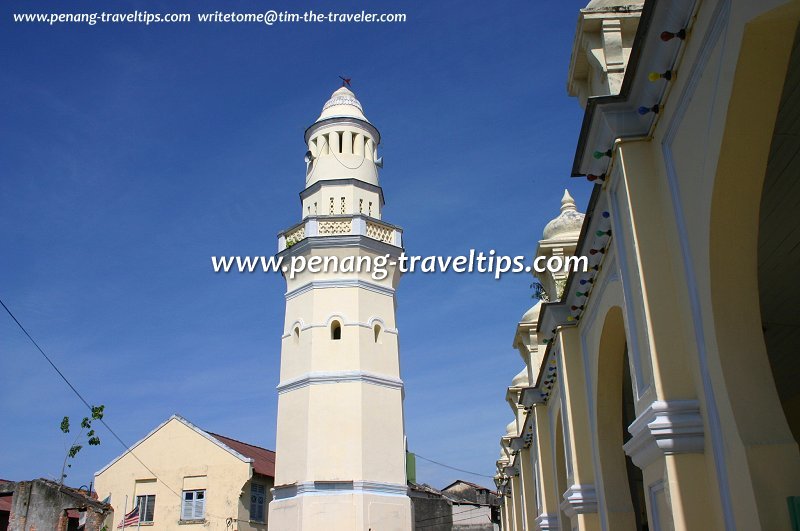 George Town World Heritage Site (4 February 2009)
George Town World Heritage Site (4 February 2009)
George Town World Heritage Site is an area within the inner city of George Town that has been recognised by UNESCO for its universal outstanding attributes. On 7 July 2008, Melaka and George Town were fêted as Malaysia's newest UNESCO World Heritage Sites. This is the first time that cultural sites in Malaysia have been inscribed into Unesco's prestigious World Heritage Listing. But what is the George Town Unesco World Heritage Site, what is its history, where is it? In this feature article, I am providing background information on the inscribed site in George Town (as relevant to Penang Travel Tips) and will handle Melaka separately. By the way, the official title for the inscription should read "Melaka and George Town, Historic Cities of the Straits of Malacca". "George Town Unesco World Heritage Site" is just an inofficial definition for one of the two component sites inscribed in the list.
Map of George Town World Heritage Site
How to go to the George Town World Heritage Site
You can reach the George Town World Heritage Site by taking the Penang Hop-On Hop-Off Tourist Bus. Many public buses also ply the area, including the free City Hop-On Transit bus.About the UNESCO Inscription
Here is the Nomination Dossier submitted to UNESCO. "Melaka and George Town, Cities of the Straits of Malacca" was inscribed as a UNESCO World Heritage Site during the 32nd session of the World Heritage Committee which met in Quebec City, Canada, on 2-10 July, 2008.World Heritage Site Inscription Details
Inscription Year: 2008Type of Site: Cultural
Inscription Criteria: II, III, IV
The properties were celebrated for the following outstanding universal value:
- Melaka and George Town represent exceptional examples of multi-cultural tradting towns in East and Southeast Asia. They were established by trading activities that result in the blending of Malay, Chinese and Indian cultures with three successive European colonial powers, over a period of 500 years. This creates a lasting imprint on their architecture and urban form.
- Melaka and George Town are a living testimony to the multi-cultural heritage and tradition of Asia, and of the European colonial influences. The tangible as well as intangible heritage of the two cities are expressed in its religious buildings of different faiths, ethnic enclaves, spoken dialects, festivities, dances, attire, artform, cuisine and lifestyle.
- Melaka and George Town reflect the blend of influences that result in a unique form of architecture, culture and cityscape incomparable elsewhere in East and South Asia. The cities showcase an exceptional range of shophouses and townhouses from differing eras, providing snapshots of building styles and types.
Speed limit within the George Town World Heritage Site
According to The Star (28 March 2024) there is a 40kph speed limit imposed on all the roads within the World Heritage Site core zone, except for the main roads namely Jalan Dr Lim Chwee Leong, Gat Jalan Prangin, Pengkalan Weld, Pesara King Edward, Lebuh Light, Lebuh Farquhar, Jalan Sultan Ahmad Shah and Jalan Penang, where the speed limit remains at 50kph. Lim Kongsi Clan Temple, one of the sites in the core zone, George Town World Heritage Site (13 February 2005)
Lim Kongsi Clan Temple, one of the sites in the core zone, George Town World Heritage Site (13 February 2005)
Comment
It is my opinion that the inscription of the Historic Cities of the Straits of Malacca is incomplete without the inclusion of Singapore, an integral part of the Straits Settlement, and whose form of architecture and culture complements what is seen in Melaka and George Town. Contrary to popular misconception, not all in Singapore is lost; a broad section of the old town is still intact, and effort should be taken to demarcate a core zone within Singapore as part of the heritage site of the Historic Cities of the Straits of Malacca.George Town WHS: Where is it?
The Historic City of George Town, as nominated by the Malaysian Government for World Heritage Listing, covers a 109.38 hectare site on the north-east of Penang Island. This is what is regarded as the core zone. Surrounding the core zone is a 150.04-hectare band called the buffer zone. Only land area is counted - the sea is excluded.Now, the important question: where is the core zone of the Historic City of George Town? Refer to the expandable Google Map on the right. The orange line shows the boundary of the core zone while the green line shows the buffer zone. In most places, the boundary follows existing roads. One side of the road will be within the zone while the other without.
 Logan Memorial, another site in the core zone, George Town World Heritage Site (8 January 2008)
Logan Memorial, another site in the core zone, George Town World Heritage Site (8 January 2008)
The Core Zone
The core zone boundary line starts from North Beach. It follows the wall of the Convent Light Street, separating it from the St Xavier's field. The Convent Light Street is in the core zone. The St Xavier's field is in the buffer zone. It crosses Farquhar Street into Love Lane. The Church of the Assumption is in the core zone. Argus Lane (Lorong Argus) and Stewart Lane (Lorong Stewart) are in the core zone while Muntri Street (Lebuh Muntri) and the Carpenter's Guild are in the buffer zone.The core zone boundary line bisects Chulia Street (Lebuh Chulia) into two halves, one part in the core zone, another in the buffer zone. It enters Carnavon Street (Lebuh Carnavon). The Campbell Street Market is in the buffer zone. At the junction of Carnavon Street with Kampung Kaka, the boundary makes a left turn into Kampung Kaka. Then it turns right into Kampung Kolam. The Penang Tourism Information Centre is in the Core Zone.
Now the boundary line runs along Carnavon Street. It turn in at Carnavon Lane (Lorong Carnavon). It goes to about 30 feet from the end of Carnavon Lane, then crosses over to Malay Street (Lebuh Melayu). It follows Malay Street in a southeast direction. Toh Aka Lane (Lorong Toh Aka) is in the core zone. Fish Lane
 (Lorong Ikan) is in the buffer zone. The boundary line goes all the way and out into the sea, bisecting Beach Street (Lebuh Pantai) and Victoria Street (Lebuh Victoria) into core and buffer zones. The clan jetties north of Malay Street Ghaut (Gat Lebuh Melayu) is in the core zone, south of it, in the buffer zone.
(Lorong Ikan) is in the buffer zone. The boundary line goes all the way and out into the sea, bisecting Beach Street (Lebuh Pantai) and Victoria Street (Lebuh Victoria) into core and buffer zones. The clan jetties north of Malay Street Ghaut (Gat Lebuh Melayu) is in the core zone, south of it, in the buffer zone. Acheen Street Mosque, in the core zone of the George Town World Heritage Site (4 July 2004)
Acheen Street Mosque, in the core zone of the George Town World Heritage Site (4 July 2004)
The Buffer Zone
The buffer zone boundary line roughly follows the historic waterway that marked the limits of 19th century George Town, namely the Transfer Road Ditch and the Prangin Canal. I say "roughly", because the Transfer Road Ditch no longer exists, while the Prangin Canal is all but covered. Anyway, this is how it goes.From North Beach, draw a line to join with Transfer Road (Jalan Transfer). Sri Bahari Road (Jalan Sri Bahari) is in the buffer zone. Argyll Road (Jalan Argyll) is bisected into two halves. Keramat Dato Koyah is within the buffer zone.
At the junction of Transfer Road and Burmah Road (Jalan Burma), the boundary line turns southeast. It follows Burmah Road to Penang Road (Jalan Penang), then cross into Prangin Road (Jalan Dr Lim Chwee Leong). Masjid Titi Papan and Loke Thye Kee are in the buffer zone. Komtar and Prangin Mall are outside the buffer zone. The boundary line continues along Prangin Road, separating Beach Street from Bridge Street (Jalan CY Choy), down Prangin Road Ghaut (Gat Jalan Prangin) and straight out into the sea.
So that's the area that constitute the George Town Unesco World Heritage Site. I'm not making up the information according to my own whim and fancy. You can also download it directly from the Unesco site. I just make the information easier to digest.
 Sights within the Core Zone of the George Town World Heritage Site
Sights within the Core Zone of the George Town World Heritage Site
Who's in, who's out? Here's a Who's Who of those within the core zone. I am not saying that all the sights listed below are "heritage sites". I am saying that they are within the core zone of the George Town Unesco World Heritage Site. I know, to some, being in the zone is a great privilege, to others, a great tragedy. I'll leave it to you to decide.- 120 Armenian Street: House where Dr Sun Yat Sen had his base in Penang.
- 1886 Building: Oldest commercial buildings on Beach Street in its original appearance.
- ABN Amro Bank: Building along Lebuh Pantai, today housing the Royal Bank of Scotland.
- Acheen Street Mosque: Mosque of the Malay community in Inner George Town.
- Ah Quee Street: Street donated by Kapitan China Chung Keng Kwee.
- Argus Lane: Short lane at the back of the Church of the Assumption.
- Ban Hin Lee Bank Building: One of the few banks established in Penang.
- Beach Street (not the full length): One of the oldest streets in George Town.
- Boon San Tong Khoo Kongsi: Lesser known Khoo clan temple.
- Cantonese Tua Pek Kong Temple: Temple for the god of prosperity run by the Hakkas and Cantonese.
- Cenotaph: Monument to whose who died in World War I.
- Cheah Kongsi: One of the oldest Chinese clan temples in Penang.
- Che Em Lane: One of the narrowest lanes in George Town.
- Chew Jetty: Biggest of the clan jetties on the George Town waterfront.
- Chinese Chamber of Commerce: Building along Lebuh Light.
- Choo Chay Keong Temple: Temple dedicated to the Yap patron deities.
- Chung Keng Kwee Temple: Private ancestral temple of Kapitan China Chung Keng Kwee.
- Church of the Assumption: Catholic church started by Eurasians who arrived with Francis Light.
- Church Street Pier: pier on the George Town waterfront.
- City Hall: Civic building at the Esplanade.
- Clan Jetties: Jetties along the George Town waterfront associated with the different Chinese clans.
- Convent Light Street: Oldest convent school in Malaysia.
- Dewan Sri Pinang: Auditorium for live performances.
- Dewan Undangan Negeri Building: State Assembly Building, formerly the Police Court.
- Eng Tai Association: Obscure clan association in the Inner City of George Town.
- Foo Tye Sin Mansion: Huge mansion along Lebuh Light, now converted and reused.
- Fort Cornwallis: Fortress to protect the British Settlement of Penang.
- Fort Cornwallis Lighthouse: Lighthouse erected to guide ships into Penang harbour.
- Francis Light Memorial: Monument erected to commemorate the 100th Anniversary of the founding of Penang.
- Francis Light Statue: Monument erected to commemorate the 150th Anniversary of the founding of Penang.
- Francis Light's Well: Well dug for the private use of Francis Light.
- George Town Dispensary: Building at the junction of Lebuh Pantai and Gat Lebuh China..
- Ghee Hiang: One of the oldest traditional biscuit and sesame oil manufacturers in Penang.
- Government House: One of the oldest colonial buildings in Penang.
- Gudang Acheh: One of the tallest buildings along Beach Street in the 19th century.
- Hai Kee Chan: Mansion belonging to Kapitan China Chung Keng Kwee.
- Heong San Hoay Kuan / Chong San Wooi Koon: Cantonese District Association from the early 19th century.
- Hock Teik Cheng Sin Temple: Chinese temple in the Armenian Street Enclave.
- House of Yeap Chor Ee: Museum showcasing the furniture and memorabilia of late Penang tycoon Yeap Chor Ee.
- HSBC Building: One of the first buildings to be rebuilt following the Second World War.
- Immigration Department: Building which was once part of the police station complex.
- India House: Building built by prominent members of the Chettiar community.
- Islamic Council Building: Building which was Government Offices during the British administration.
- Kapitan Keling Mosque: Mosque of the Indian Muslim community in George Town.
- Kar Yin Association: An association building built in the Art Deco style, by the Jiaying (Kar Yin) Hakkas who came from Meixian county of Guangdong province.
- Kongsoon House: Office building at the corner of Lebuh Pantai and Lebuh Gereja.
- Kuan Im Teng (Kong Hock Keong): Temple of the Goddess of Mercy of Pitt Street, the oldest Chinese temples in Penang.
- Leong San Tong Khoo Kongsi: The most ornate Chinese clan temple outside of China.
- Lim Kongsi: Clan association of those holding the Lim surname.
- Logan Memorial: Monument to lawyer who fought for the rights of the locals.
- Logan's Building: Commercial building that was originally three storeys, but is now only two.
- Madrasah Hamid Arabi: Early 20th century structure that was a religious school and boarding house.
- Mahamariamman Temple: Oldest Hindu temple in Penang.
- Malayan Railway Building: Early 20th century heritage building along Weld Quay.
- Market Lane Tuak Shop: One of the few remaining tuak shops in George Town.
- Millennium Monument: Monument erected as part of the Millennium celebrations.
- Moey She Temple: Clan temple for Chinese people holding the Moey surname.
- Municipal Fountain: Fountain donated by Koh Seang Tat, a wealthy 19th century personality to the municipality.
- Nagore Shrine: Shrine to South Indian Muslim saint.
- Noordin Family Tomb: Mausoleum built by a prominent Indian Muslim merchant family.
- Ng Kongsi: Clan association of the people surnamed Ng.
- Nin Yong Temple: Clan temple of a Cantonese district association.
- Old OCBC Building: Office building along Lebuh Pantai.
- Penang Heritage Centre: Government body created to increase awareness of restoration and conservation in Penang.
- Penang Heritage Trust: Non-government organization working to upkeep and educate on heritage matters.
- Penang Islamic Museum: Museum celebrating the propagation of Islam in Penang.
- Penang State Museum: State museum housed in the building originally occupied by the Penang Free School.
- Penang Tourism Information Centre: State tourist board with brochures and other information for visitors to Penang.
- Pinang Fountain: Fountain in the form of a stylized betel-nut, at the Pesara King Edward roundabout.
- Queen Victoria Memorial Clocktower: Clock tower erected to commemorate the 60th year of the reign of Queen Victoria.
- San Wooi Wooi Koon: Cantonese District Association along Bishop Street.
- Silver Chariot Garage: Chariot used during Thaipusam procession to convey the Hindu deity Murugan.
- Standard Chartered Building: Office building along Lebuh Pantai.
- St George's Anglican Church: Main church of the British administration officers in Penang.
- Supreme Court Building: Recently restored and expanded courthouse building.
- Tan Kongsi: Clan association of those holding the Tan surname.
- Teochew Ancestral Temple: Chinese clan temple which won Unesco award for restoration.
- Thio Thiaw Siat (TTS) Building: Office building along Lebuh Pantai constructed for the estate of the late Cheong Fatt Tze.
- Town Hall: Civic building which was once a venue of social gatherings.
- Tseng Lung Fui Kon: Hakka district association housed in mid-19th century building renovated in 1920-22..
- Weld Quay Ferry & Bus Terminal: (Penang Infrastructures) Main bus terminus for George Town.
- Whiteways & Laidlow: Commercial building along Beach Street that used to house upmarket stores and offices.
- Wisma Great Eastern: Office block along Lebuh Light.
- Wisma Kastam (Malayan Railway Building): The former offices of the Federated Malay States Railway Building, now the Customs department.
- Yap Kongsi: Clan association and temple of the Yap clansmen.
- Yeoh Kongsi: Ancestral temple for Hokkien clansmen bearing the surname Yeoh.

Copyright © 2003-2025 Timothy Tye. All Rights Reserved.

 Go Back
Go Back